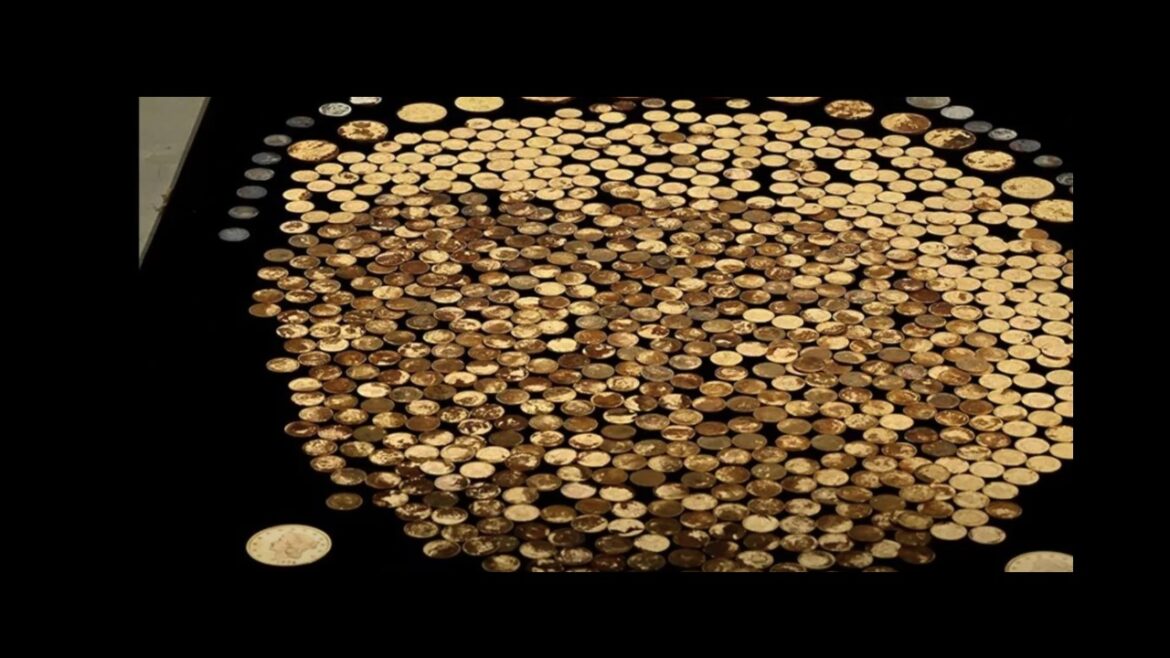Gold has all the potential to go unprecedentedly high. But silver will be gold on
Site:
Precious metals news
Keynesian policies, which involve extensive government spending and currency printing, have had unintended negative consequences in the United States. Despite the intention to stimulate the economy, these policies have resulted in a weaker labor market and financial hardships for citizens. Employment statistics reveal that the labor force participation rate and employment-population ratio remain below pre-pandemic levels, indicating a struggling job market. Furthermore, the country has experienced 26 consecutive months of negative real wage growth, meaning workers' earnings are not keeping up with inflation. Americans are heavily reliant on debt, with credit card debt reaching record highs and personal savings remaining significantly lower than before the pandemic. This has led to a decline in consumer sentiment, as evidenced by the University of Michigan Consumer Sentiment Index. The story raises concerns about the growing federal deficit, which has been exacerbated by stimulus measures, and warns that f...
 A Leading Indicator for a Recession: New York Fed Reports Surge in Credit Application Rejections
A Leading Indicator for a Recession: New York Fed Reports Surge in Credit Application RejectionsJul 20, 2023 - 06:19:27 PDT
The New York Federal Reserve Bank's monthly Survey of Consumer Expectations has revealed worrisome trends in credit application rejections in the United States. The report shows that the overall rejection rate for credit applicants has soared to its highest level since June 2018, reaching 21.8 percent compared to 17.3 percent in February. This rise in rejections was observed across various age groups, with the most significant impact felt among individuals with credit scores below 680.
The rejection rates for different types of credit applications also saw substantial increases. Auto loan rejections hit a record high since 2013, rising from 9.1 percent in February to 14.2 percent. Rejections for credit card applications, credit card limit increases, mortgages, and mortgage refinance requests climbed to 21.5 percent, 30.7 percent, 13.2 percent, and 20.8 percent, respectively.
The survey further noted that the average probability of loan rejection sharply increased for auto loans, credit cards, credit limit...
The U.S. Federal Reserve's upcoming launch of "FedNow" has sparked concerns and criticism within the financial industry. While the service aims to modernize the payment system by enabling faster transactions, there are apprehensions about its potential negative consequences.
Many major banks initially opposed FedNow, deeming it redundant compared to existing private sector real-time payment systems. However, they reluctantly joined in to expand their service offerings and maintain a competitive edge. This move has raised questions about the necessity and effectiveness of FedNow.
Some market participants worry that the rapid outflows facilitated by FedNow could potentially lead to bank runs, especially in light of the recent failure of Silicon Valley Bank. These concerns are further amplified by the limited tools available to banks to mitigate such outflows.
There are also uncertainties regarding the costs associated with FedNow. While it is stated that consumers will not be directly charged, it remains un...
Jul 20, 2023 - 05:49:04 PDT
While FedNow, the new instant payments service launched by the U.S. Federal Reserve, dramatically speeds up transactions, the central bank has clarified that it is not related to a central bank digital currency (CBDC). Despite the increase in discussions around the world about the implementation of CBDCs, the Federal Reserve has stated that FedNow is neither a form of currency nor a step towards eliminating any form of payment, including cash.
FedNow is designed to improve the infrastructure of financial transactions, making it faster and more convenient, and operates 24/7. Its real-time payment network uses commercial banks as intermediaries and can process payments within seconds. On the other hand, a CBDC would represent a fundamental change to the monetary system, creating a digital form of a nation's currency managed by the central bank. The development and implementation of a CBDC would have broad implications for monetary policy, financial stability, and the banking sector.
Officials such as Treasu...
 GOLD, SILVER & DOLLAR UPDATE JULY 20th: Recent Precious Metals Rally Due To Weak Dollar... What's Next
GOLD, SILVER & DOLLAR UPDATE JULY 20th: Recent Precious Metals Rally Due To Weak Dollar... What's NextJuly 20, 2023
The Precious Metals Rally since the beginning of July was due to a weaker Dollar. So, what's next... especially after the Dollar rallied today, pushing the metals lower. In this update, I show longer-dated charts that may provide us with some interesting clues...
A significant financial development may be on the horizon as the BRICS nations—Brazil, Russia, India, China, and South Africa—are reportedly considering the introduction of a joint currency backed by gold. This proposal, which aims to "de-dollarize" the global economy, will be discussed during the BRICS summit in Johannesburg from August 22 to 24.
The move to establish a gold-backed currency comes as a response to concerns over the potential weaponization of the US dollar through economic sanctions. With over 40 countries, including Algeria, Argentina, Egypt, Mexico, Nigeria, Saudi Arabia, and the United Arab Emirates, expressing interest in joining BRICS, the initiative is gaining momentum.
While some experts believe the creation of a common BRICS currency similar to the euro is unlikely to happen soon, the possibility of a commodity-backed currency has sparked intense discussions on social media. Authors like Robert Kiyosaki, known for "Rich Dad Poor Dad," have highlighted the potential impact of a gold...
 Presidential Candidate RFK Jr Vows To Back US Dollar With Bitcoin Or Gold If Elected President
Presidential Candidate RFK Jr Vows To Back US Dollar With Bitcoin Or Gold If Elected PresidentJul 19, 2023 - 13:16:41 PDT
Democratic presidential candidate Robert F. Kennedy Jr. has unveiled an ambitious plan to back the United States dollar with hard assets, particularly gold and silver, in an effort to strengthen the American economy. Speaking at a Heal-the-Divide PAC event, Kennedy emphasized the historical value and stability of precious metals in supporting the currency.
According to Kennedy, backing the U.S. dollar with gold and silver would help restore confidence in the currency, combat inflation, and promote long-term financial stability. He highlighted the track record of these precious metals as a store of value and their ability to mitigate the risks associated with fiat currencies.
Kennedy's plan proposes a gradual implementation, starting with a small percentage of Treasury bills being backed by gold and silver. He intends to assess the impact and adjust the level of backing based on the success of the initiative. This approach allows for a cautious transition and minimizes potential disruptions to the economy....
Jul 19, 2023 - 13:04:32 PDT
The deliberate concealment of information by the global banking industry raises serious questions about its integrity and accountability. The decision by the Swiss Parliamentary Commission of Inquiry to lock away its findings on the collapse of Credit Suisse for 50 years is a blatant affront to transparency and the public's right to know. This secretive approach is not an isolated incident but a recurring pattern. During the 2008 financial crisis, the Federal Reserve withheld crucial details of global bank bailout information, including the names of banks and the amounts borrowed. The Fed's resistance to transparency and its lengthy legal battle to prevent the release of this information raises suspicions of misconduct and hidden agendas. It is deeply troubling that major global banks, including Citigroup and JPMorgan Chase, have faced minimal consequences for their involvement in fraudulent activities, while critical documents and evidence are sealed, protective orders are granted, and information is hea...
Jul 19, 2023 - 12:52:25 PDT
Deflation is becoming a growing concern for stocks, reminiscent of the challenges faced during the 2008 financial crisis, according to Morgan Stanley's chief stock strategist, Mike Wilson. He warns that falling prices erode firms' pricing power, leading to a negative impact on earnings and stock valuations. While easing consumer and producer prices have initially been interpreted as positive news for stocks, Wilson cautions that the shift from disinflation to deflation could pose a significant headwind. The effects of rate hikes take time to surface, and there is a possibility that prices may actually decline. This scenario is particularly worrisome as companies have relied on passing on higher costs to customers during a period of inflation. Signs of deflation are already emerging, including declining housing and car prices, as well as price drops in sectors such as airlines and hotels. Wilson emphasizes the need for caution among equity investors, as the current market conditions mirror the slippery slo...
In the midst of a mounting wave of corporate bankruptcies, fears are deepening on Wall Street as the global economy teeters on the brink of deflation. The surge in corporate debt distress, which has already surpassed $500 billion, threatens to impede economic growth and strain credit markets that are still recovering from historic losses.
This distressing scenario is fueled by the weight of soaring debt levels accumulated during a period of unprecedentedly low interest rates. Central banks, caught off guard by surging inflation, are deliberately tightening monetary policy to slow down economies and restrict credit flow, resulting in an inevitable wave of business failures.
The vulnerability is particularly acute in sectors burdened by excessive debt, as companies struggle to cope with ballooning obligations. In the US, high-yield bonds and leveraged loans more than doubled to $3 trillion since 2008, before the Federal Reserve embarked on aggressive rate hikes. Non-financial Chinese companies also grapple ...
On July 17, 2023, fears intensified regarding China's economy, which appeared to be on the verge of deflation. The latest economic data showed underwhelming performance, causing concerns about stagnating growth and prompting calls for more significant policy intervention. Beijing announced that the country's GDP growth for the second quarter was 6.3% year-on-year, falling short of market expectations of 7.3%. This marked a slower growth rate of 0.8% from the previous quarter's 2.2% quarter-on-quarter pace.
Adding to the worries, China's producer prices experienced a significant decline of 5.4% in June compared to the previous year, marking the ninth consecutive drop and the steepest decline since December 2015. Additionally, annual consumer price inflation remained flat in June, driven by a substantial 7.2% decrease in pork prices, which missed expectations.
Although the People's Bank of China pushed back against the deflation narrative, some economists pointed to other indicators indicating a serious ris...
Investment banks are growing increasingly pessimistic about the dollar as they anticipate a soft economic landing, leading to a reduced need for the US Federal Reserve to raise interest rates. Major lenders such as Morgan Stanley, JPMorgan Chase, Goldman Sachs, and HSBC have abandoned their bullish dollar calls or predicted further declines in the currency following last week's significant drop in US inflation. The US currency hit a 15-month low against a basket of currencies, fueling expectations that the Fed could soon end its monetary tightening campaign without pushing the world's largest economy into a recession. Analysts at HSBC believe that the signs of global growth improvement and a US soft landing will pave the way for dollar weakness, anticipating a breakout from the tight trading range seen since late 2022. Goldman Sachs analysts also expect a substantial decline, suggesting that the recent move is just the beginning. Morgan Stanley and JPMorgan have adjusted their positions, with the former s...
The recent University of Michigan survey indicates that one-year inflation expectations rose to 3.4% in July, while the five-year outlook increased to 3.1%. There is a mainstream narrative that is growing all over the financial media: We must accept three percent annual inflation as a success at combating rising prices. This is enough to pivot and return to monetary easing. It is not. Sustained three percent inflation over a decade results in a 34% loss in purchasing power, exacerbating the already dire inflationary environment. Rising long-term inflation expectations not only erode wages and savings but also incentivize the persistence of inefficient sectors while discouraging innovation and technological advancements. Despite this, there is a demand for more quantitative easing, driven by the desire for market bubbles, even at the expense of weak economic growth and declining wages. The reality is that a three percent average inflation rate leads to higher costs of essential goods and services, as seen ...
Over the last two months we have seen an unprecedented acceleration of what Mike Maloney refers to as ‘The Death of the Global US dollar Standard’.
 74% of Americans Have Financial Regret for Not Saving Retirement Early Enough: Survey
74% of Americans Have Financial Regret for Not Saving Retirement Early Enough: SurveyJul 19, 2023 - 07:22:58 PDT
A recent Bankrate survey reveals that financial regrets are pervasive among U.S. adults, with a staggering 74 percent expressing remorse over their financial decisions. From failing to save for retirement early enough to taking on excessive credit card debt or not setting aside enough for emergencies, it's clear that many Americans are grappling with the consequences of past choices.
Greg McBride, Bankrate's Chief Financial Analyst, highlights the striking trend: "Despite rising debt levels and higher interest rates, regrets over lack of savings continue to outpace regrets related to debt." This sentiment is echoed by a substantial portion of Americans who feel that their top financial regret stems from not saving enough for retirement, emergencies, or their children's education, rather than regretting the accumulation of credit card debt or student loan debt, or buying a home beyond their means.
The survey findings also shed light on generational differences. Baby boomers, aged 59-77, are most likely to ...
A Kentucky man hit the jackpot when he uncovered money in a cornfield.The unidentified man unearthed 741 $1 coins along with a number of $10 and $20 pieces. There were more than 800 coins in the hoard with a face value of well over $1,000.Oh, and the coins were gold and silver, so they are worth many times more than that today.
Millions of Americans are bracing for a significant blow to their household budgets as federal student loan payments resume in September, according to a new study by TransUnion. The report reveals that around 27 million student debt holders, who have been granted a freeze during the pandemic that lasted over three years, will now have to resume payments. For a significant portion of these borrowers, approximately half, the monthly payment will exceed $200, while one in five will face payments exceeding $500. This abrupt increase in financial obligations is expected to create a payment shock, requiring borrowers to readjust their monthly budgets. The restart of student loan payments adds to the financial challenges faced by US consumers, who have already endured rising interest rates and accumulated additional debts during the pandemic. Older borrowers, burdened with higher student loan debts, will face even larger monthly payments. Despite the Biden administration's attempts to alleviate the debt burden t...
We are all keenly aware of price inflation. We notice those rising prices every time we go into a store. But the inflation boogeyman is hitting you even harder than you realize. Not only are you paying more for pretty much everything you buy, you're getting less.Literally.It's called shrinkflation.
US Housing Starts and Building Permits experienced a disappointing decline in June, with a significant decrease of 8.0% MoM for Starts and 3.7% MoM for Permits. Moreover, Starts saw substantial downward revisions from the previous month, with a revision from a positive 21.7% MoM to a lesser 15.7% MoM.
The decline in construction activity was primarily driven by a drop in multi-family permits and a decrease in both single- and multi-family Starts. The only positive aspect was the continued increase in single-family building permits for the sixth consecutive month.
As a result of these monthly declines, the Starts and Permits SAAR (seasonally adjusted annual rate) experienced a notable decrease, reaching 1.434 million and 1.440 million respectively.
Interestingly, although Housing Starts and Completions are far below their peak levels in 2022, Construction Jobs remain relatively high. However, there are concerns about a potential downturn in residential construction employment.
In addition, data from the Mo...
If you buy a gold bar or gold coin, you get beautiful, shiny metal. Of course, gold doesn't come out of the ground that way. Gold ore basically looks like — well- a rock.In order to extract pure gold, refiners put the ore through a multi-step process.









